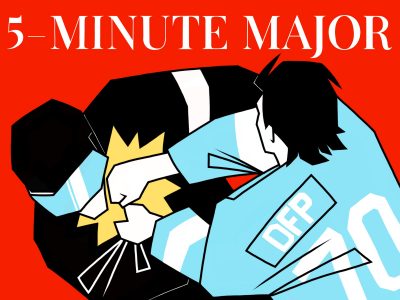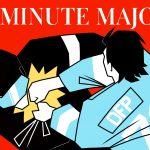Matt Rempe has captured the hockey world.

The New York Rangers’ 6-foot-7, 21-year-old center made his NHL debut on February 18, already making history as the first forward to make his debut in an outdoor game.
No one cared about that piece of history. People cared that in his first week in the NHL, he had four drop-the-mitts fist fights in his first five games and more penalty minutes than time on ice.
Rempe is an example of a dying breed in hockey. The extinction of that breed has been polarizing.
The enforcer was a role essentially every team had from the 1980s through the early 2000s. The enforcer didn’t need to have a good shot, ice awareness or speed. The entire expectation was that the enforcer would do as the name suggests: If the game was getting chippy, if a dirty hit was made or the goalie was touched, the enforcer would come in and pick a fight with the perpetrator.
However, as the game has evolved to be more skills-based with faster skating and more goal-scoring, the need for a specialized enforcer has dwindled because the game has become less violent.
Rempe has become an example of why the role has died off almost entirely.
He got into a fight with forward Matt Martin of the New York Islanders in his first ever shift in the NHL.
In his third game, he laid his shoulder into the face of New Jersey Devil forward Nathan Bastian, who crumpled to the ice with a bloody nose. Bastian hasn’t played a game since that hit, over a month ago, though that is due to a different injury.
Rempe also took Toronto Maple Leaf defenseman Ilya Lyubushkin out of a game with a head injury.
Two weeks ago, Rempe was suspended four games for elbowing Devils defenseman Jonas Siegenthaler in the jaw. Siegenthaler hasn’t returned to play since either, this time due to a concussion caused by that hit.
This style of play has no place in hockey. Rempe has left a trail of injuries in his wake since he entered the league.
Fighting, however, belongs in hockey.
One of the best parts of the NHL is that the players police themselves. No dirty hit goes without consequence, even if the referees don’t take notice of the injustice.
Fights are almost always consensual. Someone will drop their mitts to instigate instead of just going at a player. Both parties drop the mitts, and the fight begins. There is a mutual understanding of what both players are signing up for as they circle each other, waiting for one to horsecollar the other to start throwing punches.
The referees understand, too. They will let the fights go as long as they’re equal. As soon as the balance is lost, they step in. Someone’s jersey will get pulled over their head, or someone will get pushed to the ground, and the refs will separate the two, usually with little resistance because the players know their point was made. And the refs understand the players need to work things out themselves.
Maybe most important to the sport of hockey, though, is that fans love fighting. I include myself in this.
Fighting, the way it is usually handled in games, is not the problem in hockey. Dirty hits that land players on the injured reserve are.
Fighting can serve as a spark for teams that are playing a little sleepy. It brings the crowd into the action.
Fights belong in hockey. Enforcers do not.











